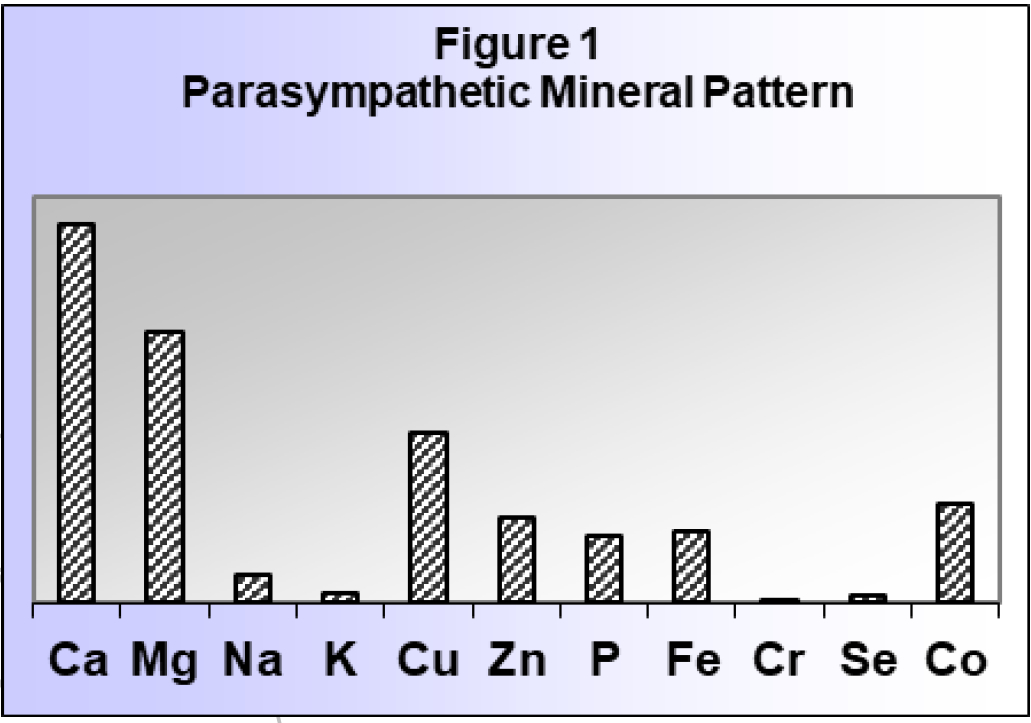Many individuals who have had COVID-19 are developing long-Covid that includes a collection of symptoms that can last months and possibly years following infection. Some symptoms include mild to extreme fatigue, reduced exercise tolerance, brain fog or inability to concentrate, skin conditions, hair loss, paresthesia, headaches, joint pains, change in taste and smell, dizziness when standing, and menstrual irregularities in females. This is not a complete list of symptoms, but a short list of the most common symptoms that are independent of age, sex, or race. However, some studies have reported that women may be more susceptible. It is estimated that twenty-million people in the U.S. and over half of those who were diagnosed with COVID-19 worldwide, are experiencing long-COVID symptoms and there is currently no treatment or tests that can diagnose it.
HTMA Patterns Associated with Viral Infection and Viral Susceptibility
As we have discussed in the past it is evident that certain HTMA patterns are associated with viral susceptibility and that viruses can contribute to those mineral patterns as well. The parasympathetic mineral pattern is associated with a dominant cellular immune activity that may be triggered by viruses and which may lead to increased viral susceptibility and long-term complications of viral infections. As we have observed over decades of HTMA tests performed on individuals and groups, there are mineral patterns associated with ongoing and past viral conditions such as severe flu, mononucleosis, Epstein Barr virus (EBV), cytomegalovirus (CMV), and others. The pattern is predominantly that of a slow metabolic type with high tissue concentrations of calcium and copper and a low zinc to copper ratio. Many have had long-term residual effects from these conditions as well and show a sustained HTMA pattern shown in Figure 1 with an increased and
prolonged cellular immune response. This can lead to autoimmune conditions such as Sjogren’s syndrome, lupus, chronic fatigue syndrome (CFS), fibromyalgia, multiple sclerosis, thyroid disorders, and others. Many may suffer from Post Viral Fatigue Syndrome (PVFS) months to years following a viral condition.
Also, it is known that calcium can enhance viral manifestations and high tissue calcium is a characteristic seen in females.

Studies of long-Covid cases have found similarities with autoimmune conditions such as CFS, fibromyalgia etc.
One should also be aware that many symptoms of Long-Covid again are similar to CFS, which could be due to underlying dormant viruses such as CMV and EBV becoming active and proliferating following the superimposition of another virus such as COVID-19.
Zinc Deficiency
Interestingly some of the symptoms associated with zinc deficiency such as loss of taste and smell are seen in many patients who had COVID-19 and as well as those suffering from long-COVID. White spots appearing in fingernails has been associated with zinc deficiency following a viral episode although this has not been widely reported.
Hair loss is another condition associated with long-Covid and may be associated with zinc deficiency. For example, a case control study was performed in women with androgenic alopecia hair loss. Even though this is a genetic condition it is thought that minerals may play a role in the condition. The study compared the serum, hair zinc and iron in affected women compared to a nonaffected group. Results found that
serum and hair zinc and iron levels were markedly lower in women experiencing hair loss compared to the control group. Dhaher SA, et al. Estimation of Zinc and Iron in the Serum and Hair of Women with Androgenetic Alopecia: Case-Control Study. Indian J Dermatol. 63,5, 2018.
Zinc deficiency may also help explain the skin conditions that occur with long-COVID. A study was performed to determine if a relationship could be found between HTMA zinc levels and the incidence of atopic dermatitis and if a relationship was found would oral zinc supplementation be helpful in those with the condition. The study consisted of fifty-eight children including males and females diagnosed with atopic dermatitis. The mean age was 6.2 years. A control group was also established. HTMA studies found that those affected
with atopic dermatitis had significantly reduced zinc levels compared to controls. Zinc supplementation was begun for a period of eight weeks and then both groups were reevaluated. Clinical improvements were noted in the zinc supplemented group and HTMA zinc levels increased to normal values compared to controls. Kim, JE, et al. Hair Zinc Levels and the Efficacy of Oral Zinc Supplementation in Children with Atopic Dermatitis. Acta Derm Venereol, 94, 2014.
Fatigue, Muscle Fatigue and Soreness, Brain Fog
Many more of the symptoms related to long-Covid could be explained by the HTMA findings related to parasympathetic dominance. For example, autonomic neuroendocrine system dysregulation may develop including adrenal insufficiency, hypothyroidism, increased parathyroid and thymus activity and high insulin levels. As cited in our Web News Updates many who have had COVID-19 were examined by Jamal, et.al. were found to have met the criteria for postural orthostatic tachycardia syndrome (POTS). Symptoms of POTS include, lightheadedness, fainting, poor concentration, brain fog, fatigue, poor exercise tolerance, blurred vision, tremors, palpitation, and nausea.
These symptoms are associated with increased parasympathetic dominance over the sympathetic branch. Again, parasympathetic dominance is associated with an increased cellular immune response which suppresses the humoral immune response. Many of the symptoms of muscle weakness and poor exercise tolerance could be related to a disruption in neurotransmitters involving acetylcholine. Some autoimmune conditions can produce antibodies toward acetylcholine nicotinic receptors. Adrenal insufficiency associated with low sodium and potassium retention could lead to disruption of Na and K ATPase activity, contributing to extreme fatigue, muscle weakness and joint soreness, due to a further increase in cellular calcium accumulation. Some studies have found low cortisol levels in patients with long-COVID symptoms.
Indications for Nutritional Support
Viewing the HTMA pattern in Figure 1 we can determine specific nutritional indications that would be supportive. An elevated Ca/P ratio would indicate a need for more phosphorus in the diet. An elevated Ca/Mg ratio would indicate a need for additional magnesium and magnesium co-factors. Even though magnesium itself is elevated the ratio between calcium and magnesium is important. The high Ca/Mg pattern is suggestive of parathyroid dominance and magnesium therapy would help in reducing parathyroid expression, as well as help prevent further calcium deposition into cells and tissues thereby reducing viral susceptibility.
Zinc is known to have anti-viral properties. Based upon a low Zn/Cu ratio, zinc and zinc co-factors would be beneficial in reducing excess copper. Tissue copper tends to rise during prolonged viral conditions and contributes to soft tissue calcium accumulation. Nutritional factors that aid in lowering as well as increasing the mobilization of excess tissue copper would be considered anti-viral such as vitamins C, A, niacin, zinc, and molybdenum. Elevated tissue copper is also linked to yeast and fungal susceptibility which should be addressed by the same anti-viral nutrients. Low sodium and potassium levels should be addressed not only through diet, but also through adrenal support which would aid in improving sodium and potassium retention. Low sodium and potassium can be indicative of low hydrochloric acid leading to poor protein digestion, helicobacter, and disturbance in the microbiome. Other issues may also be addressed if clinically evident, such as anemia and blood sugar issues. These would include iron therapy as well as glucose tolerance factors.
Contraindications
Based upon the HTMA pattern in Figure 1, some nutritional contraindications would be obvious, such as avoiding high calcium intake and high copper foods as well as foods having a high glycemic index. Even though low vitamin D is often found in individuals with this mineral pattern and has been reported in COVID-19 patients, high vitamin D intake would be unwarranted and contraindicated. Since the parasympathetic mineral pattern is associated with increased parathyroid expression, excess tissue calcium is contributed to largely from bone. Low vitamin D levels would be considered a protective adaptation by reducing intestinal calcium absorption and thereby reducing further tissue calcium deposition. Antonelli, et al. reported that the low vitamin D in COVID patients may be due to acute and subacute or low-grade inflammatory conditions. They describe vitamin D being low due to it being a negative acute phase reactant. M. Antonelli, et al. Low Serum Levels of 25-Hydroxyvitamin D Accompany Severe COVID-19 Because it is a Negative Acute Phase Reactant. Am.J.Med.Sci. Sept
2021
Since the parasympathetic mineral pattern is associated with a dominant cellular immune response which could trigger an auto-immune reaction, thymus support should be excluded.
Conclusion
HTMA data indicates that individuals may have mineral patterns that reflect past and on-going viral conditions as well as long-term post-viral impacts, such as post-viral fatigue syndromes. These mineral patterns may provide targeted nutritional therapeutics for those individuals affected.
Author: Dr. David L. Watts
https://traceelements.com/docs/NewsletterSeptember-October2022.pdf

